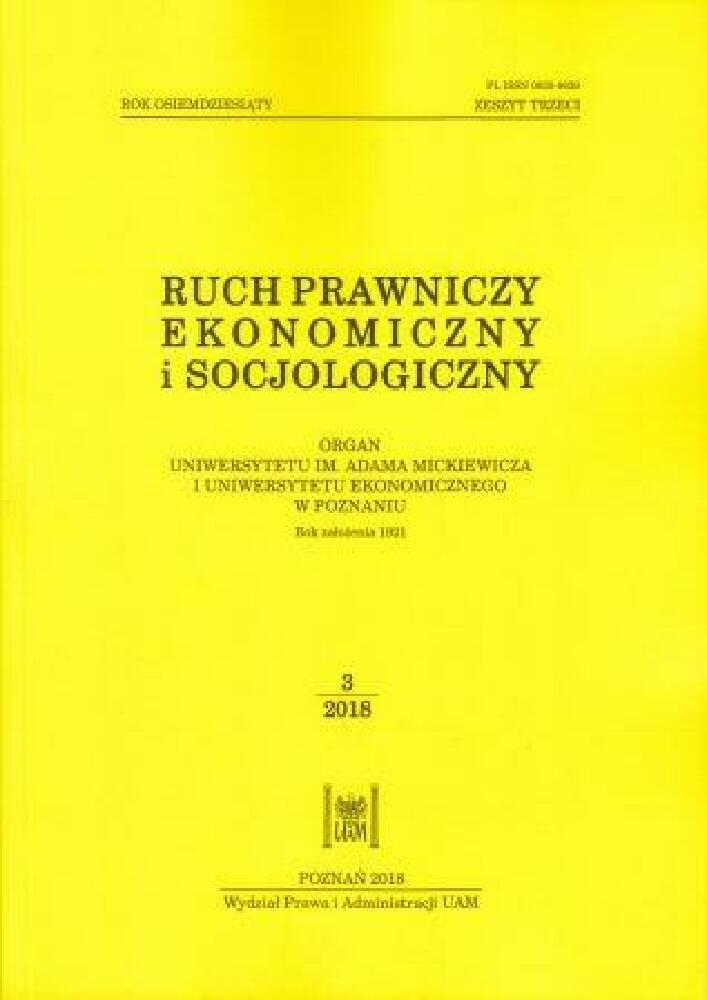Abstrakt
Artykuł analizuje regulacje prawne dotyczące świadczeń dla imigrantów z tytułu bezrobocia, ukazując je jako element polityki integracji imigrantów w Polsce. Poszczególne kategorie cudzoziemców mają bardzo zróżnicowany dostęp do instrumentów przeciwdziałania skutkom utraty zatrudnienia. Najszersze uprawnienia (zrównane z prawami obywateli polskich) mają imigranci z zezwoleniem na pobyt stały i rezydenci długoterminowi UE, imigranci przymusowi oraz imigranci z państw UE/ EFTA. Heterogeniczność tych kategorii, różnorodność podstaw uzyskiwania praw pobytowych skłania jednak do wniosku, że polityka integracji leżąca u podłoża przepisów wobec poszczególnych grup charakteryzuje się różnymi założeniami i celami. W przypadku imigrantów permanentnych założeniem polityki integracji jest zapewnienie dostępu do instytucji państwa dobrobytu osobom, które w Polsce mają ośrodek interesów życiowych, są trwale powiązane z polskim rynkiem pracy i systemem zabezpieczeń społecznych. W przypadku imigrantów przymusowych uzasadnieniem polityki umożliwiającej dostęp do świadczeń są względy humanitarne. Przyjęcie takich osób na terytorium RP ma charakter charytatywny i nie może być postrzegane w kategoriach kalkulacji finansowych zysków i strat. Z kolei ukształtowanie polityki integracyjnej w zakresie dostępu do świadczeń społecznych imigrantów z państw UE/ EFTA wynika z konieczności przestrzegania porządku unijnego, w szczególności zapewnienia bezproblemowej realizacji zasady swobodnego przepływu pracowników. Najliczniejszą kategorią imigrantów w Polsce są jednak imigranci krótkoterminowi przybywający w ramach zezwoleń na pracę sezonowa oraz systemu oświadczeń, którzy nie są włączeni do systemu ochrony przed bezrobociem oraz od których oczekuje się wyjazdu po wykonaniu pracy.Finansowanie
Artykuł powstał w ramach grantu Narodowego Centrum Nauki nr 2014/14/Z/HS4/00006
Bibliografia
Andrejuk, K. (2018), Jacy imigranci rejestrują się jako bezrobotni? Dynamika bezrobocia wśród cudzoziemców w RP, Studia Migracyjne – Przegląd Polonijny 2.
Andrejuk, K. (2017), Przedsiębiorcy ukraińscy w Polsce. Struktura i sprawstwo w procesie osiedlenia, Wyd. IFiS PAN, Warszawa.
Borjas, G.J., Immigration and Welfare Magnets, Journal of Labor Economics 17(4): 607–637.
Bratsberg, B., Oddbjørn, R., Røed, K. (2014), Immigrants, Labor Market Performance, and Social Insurance, IZA Discussion Paper No. 8292, Bonn.
Brunarska, Z. (2014), Ukraińscy migranci zarobkowi w Polsce – dlaczego tak trudno ich policzyć?, Studia BAS 4(40): 155–174.
Drabek, A. (2016), Komentarz do art. 87, [w:] Góral, Z. (red.), Ustawa o promocji zatrudnienia i instytucjach rynku pracy. Komentarz, wyd. 2, Wolters Kluwer, Warszawa.
Geddes, A. (2018), The governance of migration in Europe: towards fragmentation?, [w:] Triandafyllidou, A. (ed.), Handbook of Migration and Globalisation, Edward Elgar Publishing.
Grzymała-Kazłowska ,A., Stefańska, R. (2014), Cudzoziemcy korzystający z ochrony w Polsce, Studia BAS 4(40): 197–222.
Joppke, C. (2007), Beyond national models: Civic integration policies for immigrants in Western Europe, West European Politics 30(1).
Ersanili, E., Koopmans, R. (2010), Rewarding integration? Citizenship regulations and the socio-cultural integration of immigrants in the Netherlands, France and Germany, Journal of Ethnic and Migration Studies 36(5).
Penninx, R. (2005), Integration of migrants: economic, social, cultural and political dimensions, [w:] Macura, M., MacDonald. A.L., Haug, W. (eds.), The New Demographic Regime Population Challenges and Policy Responses, UN.
Puzio-Wacławik, B. (2008), Polityka państwa na polskim rynku pracy, [w:] Dach, Z. (red.), Państwo a rynek, PTE, Kraków: 27–51.
Razin, A., Wahba, J. (2015), Welfare magnet hypothesis, fiscal burden, and immigration skill selectivity, The Scandinavian Journal of Economics 117(2): 369–402.
Sabates-Wheeler, R., Feldman, R. (2011), Introduction: Mapping migrant welfare onto social provisioning, [w:] Sabates-Wheeler, R., Feldman, R. (eds). Migration and Social Protection: Claiming Social Rights Beyond Borders, Palgrave Macmillan: Houndmills
Sainsbury, D. (2006), Immigrants’ social rights in comparative perspective: welfare regimes, forms in immigration and immigration policy regimes, Journal of European Social Policy 16(3): 229–244.
Ślebzak, K. (2012), Koordynacja systemów zabezpieczenia społecznego. Komentarz, Wolters Kluwer, Warszawa.
Uścińska, G. (2013), Zabezpieczenie społeczne osób korzystających z prawa do przemieszczania się w Unii Europejskiej, Wolters Kluwer, Warszawa.
Wap, S. (2013), Aktywne polityki rynku pracy – dobry sposób na walkę z bezrobociem?, Analiza FOR 3, Warszawa.
Licencja
Prawa autorskie (c) 2018 WPiA UAM

Utwór dostępny jest na licencji Creative Commons Uznanie autorstwa – Użycie niekomercyjne – Bez utworów zależnych 4.0 Międzynarodowe.




